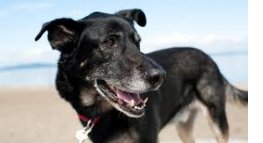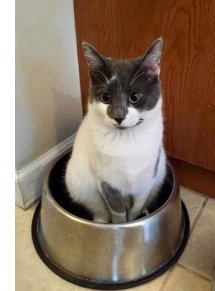6 Tricks to get your finicky cat to eat more:
|
"Wet" your kitty's appetite.
Just like people, cats have preferences in taste and texture when it comes to food. Many cats will prefer foods with higher moisture content, unless they have been fixed on dry food. If your kitty seems uninterested in dry food, try switching it up and offering moistened food instead.
Try warming their food.
For many kittens used to the warm comfort of their mother's milk, cold food can seem unfamiliar and ultimately turn them off. Warming your kitten's canned food can help ease the transition to solid food. This tip doesn't just pertain to kittens, though. Your older cat may prefer warmed food as well.
Add a little bit of tuna juice.
According to Dr. Larsen, many cats enjoy the flavor of proteins and amino acids. To entice your kitty to eat, try adding a little tuna juice to his fare. A little more flavor might be all he needs. Be sure to use tuna packed in water — not oil.
Offer it when you know your cat is hungry.
If your cat refuses to dine, it may be that he just isn't hungry. “The reputation for being finicky may be related to the fact that many cats, especially those who live indoors, have low energy requirements and don't need to eat much food to maintain their weight,” Dr. Larsen says. Sticking to a regular feeding schedule so that you are only offering food when you know your cat is hungry could solve the pickiness problem. Talk to your vet about the best feeding schedule for your cat.
Praising and petting your feline at mealtime may also increase your kitty's responsiveness.
Your feline friend probably loves to please you, so praising him when he eats will likely seem like a good incentive to him. Extra petting sessions are an especially great bonus.
Seeing other cats in the household relishing the offering can also help.
Try feeding all of the cats in your household at the same time (but keep in mind that they may need to be fed in different areas to keep any drama to a minimum — creating a stress-free eating environment is also important!). Seeing his feline siblings devouring a delicious meal might just be the only push your picky eater needs.
|
|
 |
|
Are you signed up for FREE REWARDS at
Largo Veterinary Hospital?
|
| 1000 points = $25 credit to your account OR a free nail trim
How do you sign up?
Activate your
VetScene Portal here:
Activating your account automatically gives you 200 points
Every dollar you spend on services or products = 1 point
There are more ways to earn points too, once you sign up we'll email you all the details!
|
|
|
|
|
|
|
February is Pet Dental Month
|
Don't ignore your pet's bad breath. It's the most obvious sign that your pet's teeth need a check up from Dr. Daniels.
Dental health is a very important part of your pet’s overall health, and dental problems can cause or be caused by other health problems. Your pet’s teeth and gums should be checked at least once a year by Dr. Daniels. She'll be looking for signs of a problem with the goal of keeping your pet’s mouth healthy.
Have your pet’s teeth checked sooner if you observe any of the following problems:
- bad breath
- broken or loose teeth
- extra teeth or retained baby teeth
- teeth that are discolored or covered in tartar
- abnormal chewing, drooling, or dropping food from the mouth
- reduced appetite or refusal to eat
- pain in or around the mouth
- bleeding from the mouth
- swelling in the areas surrounding the mouth
Some pets become irritable when they have dental problems, and any changes in your pet’s behavior should prompt a visit to Dr. Daniels. Always be careful when evaluating your pet’s mouth, because an animal in pain is more likely to bite.
|
|
 |
|
Got a Sweet Young Gray Faced Pup?
|
 We all know that stress and anxiety have the ability to make a human’s hair turn prematurely gray; hello we've all seen Obama go gray in office. Did you know the same is true for your dog? It have been proven that dogs that experience high levels of stress or anxiety and impulsiveness are 40-65% more likely to go prematurely gray. We all know that stress and anxiety have the ability to make a human’s hair turn prematurely gray; hello we've all seen Obama go gray in office. Did you know the same is true for your dog? It have been proven that dogs that experience high levels of stress or anxiety and impulsiveness are 40-65% more likely to go prematurely gray.
Something to keep in mind, though, is that some dogs are genetically predisposed to go gray earlier than some other breeds, just like humans.
However, if you notice your pup showing signs of anxiety (trembling, whining, destructive behavior), here are a few at-home tips for managing your stressed out pup:
ThunderShirt: comfortable shirts that offer constant pressure around your dog or cat’s torso when they exhibit anxiety, similar to swaddling an infant. A study showed that the ThunderShirt effectively reduces the heartrate of an anxious pup and the pressure promotes relaxation.
Calming Chews: Calming chews contain L-theanine, which is an amino acid that can cause relaxing effects in the brain. L-theanine is often found in human-grade anti-anxiety supplements. Plus, who doesn’t love a treat?
Play Time: sometimes your pup’s anxiety may increase when she’s bored, just like a human. Regular exercise and play sessions can help alleviate all of that nervous energy. Also, if you find your pup’s anxiety to increase when you go to work, look into daycare or break up the day with a walk.
|
|
 |
|
Meet "Jazzmine" Churchfield
Our February 2017 Pet of the Month
|
I am a 7 year old Domestic Short Haired cat. I am special because although I live in my forever home I was once a stray left behind by my previous owners. Shhh…don’t tell Dr. Daniels but my favorite treat is corn! Something funny that happened to me was the time I fell out of bed. My owner loves me so much that she shares her pillow with me. I am an active cat and I love to play fetch with my ball. I am so spoiled that I get to sleep in bed with my mom.
|
|
|
How often do pet bowls need to be washed?
|
DAILY! No matter how thoroughly your cat or dog licks the food dish, it's not clean enough to use again without washing. That goes for water dishes, too. dish, it's not clean enough to use again without washing. That goes for water dishes, too.
First things first, the bowl. The cleanest and safest options for bowls are either stainless steel, or ceramic. Skip the plastic bowls completely. Plastic is not only very porous, but it can also get scratched up easily, two things that make it much easier for algae, mold, and bacteria to collect and grow.
And about that bacteria… it’s bad. The most common, and certainly most recognizable is Serratia Marcescens, also known as that “pink stuff.” Don't forget about algae colonies forming on the sides and the bottom. Who'd want to drink from that?
Serratia Marcescens has been known to cause infection and even pneumonia. And even if you don’t see the dreaded pink stuff, it doesn’t mean your dog’s water bowl is safe from ick. Yeast, mold, and coliform bacteria (which includes Salmonella and E. coli) have been found in dog bowls. And this all goes TRIPLE for our dog’s food bowls. The fat found in food is a breeding ground paradise for bacteria
So what is the best way to clean your pet's bowl? Well, a hot water rinse is so ineffective it’s comparable to doing nothing at all! Either scrub by hand with hot soapy water or run them through the hottest cycle of the dishwasher to get them really clean and sterilized. Also, be sure not to use an abrasive sponge when cleaning; avoiding scratches and grooves is important. Baking soda is also a great cleaning agent. Soon you’ll have dog bowls so clean YOU can eat off them!
|
|
 |
|
|
|